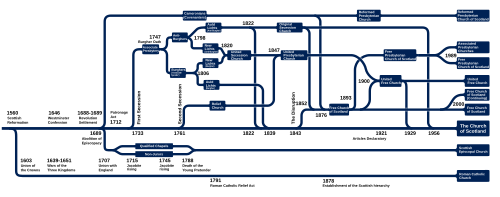Anti-Burgher
The church split in 1747 over the issue of the Burgher Oath, which required holders of public offices to affirm approval of the religion "presently professed in this kingdom".
The issue was civil compulsion in religious affairs, a forerunner of later arguments over the separation of church and state.
Opponents of the Burgher Oath on theological grounds became known as the Anti-Burgher and showed a distinctive independence of conviction and an unwillingness to compromise over sincerely held beliefs.
The more Calvinistic "Auld Lichts" held to the obligations of the Solemn League and Covenant, the "New Lichts" were more theologically liberal, a notable and continuing influence in the post-1847 United Presbyterian Church of Scotland.
The "Synod of Protesters" including George Paxton (minister) joined it in 1827 and it became the Original Secession Church.
The father was one of the 'Old Lights' who left the Anti-Burgher Secession Synod in 1806 to form the "Constitutional Associate Presbytery".
3, The son was ordained in 1821 as a minister of the 'Old Light' Anti-Burgher "Constitutional Associate Presbytery".
In 1827 the 'Old Light' Anti-Burgher Constitutional Associate Presbytery united with the 'Synod of Protesters' (which had left the New Licht' Anti-Burgher Synod in 1820-1) to form the 'Associate Synod of Original Seceders', also known as the Original Secession Church.
